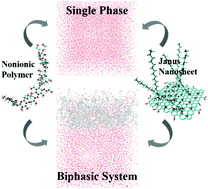Interactions between amphiphilic Janus nanosheets and a nonionic polymer in aqueous and biphasic systems†
Abstract
It is of great significance to understand the interactions between nanoparticles and polymers since they guide the development of tremendous applications, for example, in optoelectronic devices, biomedicine, and enhanced oil extraction. However, few studies have probed into this fundamental science as the emerging amphiphilic Janus nanosheets have a more complicated structure than homogeneous nanoparticles, which makes their interactions more complex. In this work, we try to understand the interactions between amphiphilic Janus nanosheets and a model nonionic polymer, hydroxyethyl cellulose (HEC), under different electrolyte and temperature conditions in both aqueous and biphasic systems by employing molecular dynamics simulations as well as experiments. It is found that the attachment of HEC onto the nanosheet surfaces exhibits ion-concentration-dependent behavior in the aqueous phase, helping to colloidally stabilize the nanosheets even in an environment with an extremely high salt concentration for a long duration. In the oil and water biphasic system, only elevated temperature promotes both Janus nanosheets and HEC to individually remain at the interface.



 Please wait while we load your content...
Please wait while we load your content...